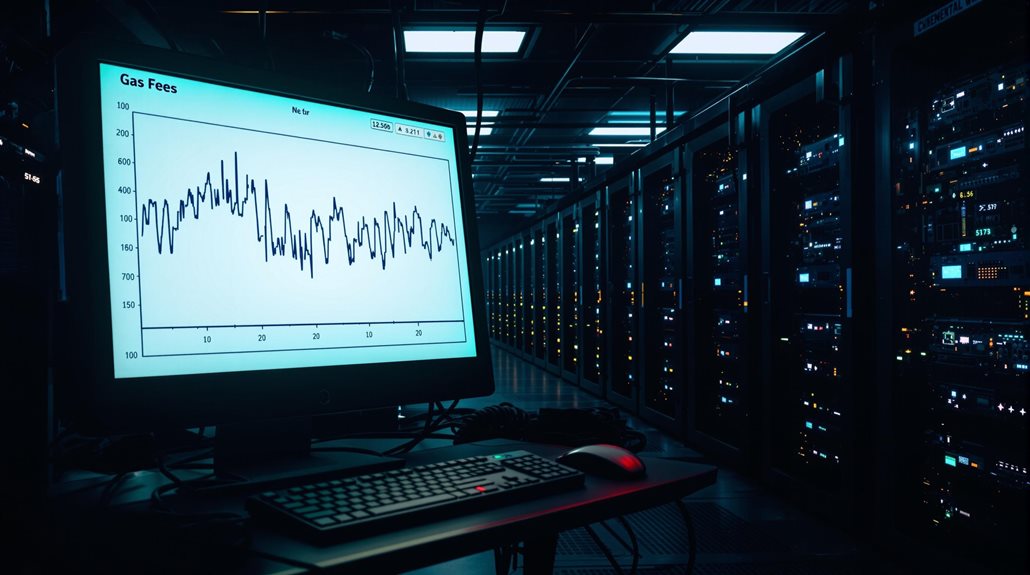Gas fees are the digital tolls users pay to process transactions on blockchain networks like Ethereum. They compensate validators who maintain the network and prevent spam attacks. These fees include a base cost that's burned plus an optional priority fee to speed up processing. The amount varies based on network traffic, transaction complexity, and cryptocurrency prices. When the network gets busy, fees can spike as users compete for faster processing times. Understanding gas fees is key to maneuvering the crypto world.

Gas fees, the digital toll collectors of the crypto world, play a vital role in keeping blockchain networks running smoothly. These fees compensate the validators and miners who process transactions on the blockchain. They're measured in tiny units, like gwei, which is just a fraction of cryptocurrencies like Ethereum (ETH). Without gas fees, networks would be vulnerable to spam attacks and abuse, making them fundamental for security and proper operation. The recent shift to proof of stake has made gas fees even more crucial as they now directly compensate validators instead of miners.
The total gas fee a user pays consists of several components. First, there's the gas limit, which sets the maximum amount of computational work allowed for a transaction. This works together with the gas price, which is the cost per unit of gas. The base fee, which is set by the network itself, gets burned (permanently removed from circulation) after the transaction is complete. Users can also add a priority fee, which acts like a tip to validators to process their transaction faster. Private blockchain networks often implement similar gas mechanics for operational control.
Network conditions heavily influence how much someone pays in gas fees. When lots of people are making transactions, fees tend to go up because there's more competition for space in the next block. Complex transactions, especially those involving smart contracts, require more computational power and hence cost more. The time of day, overall network activity, and even the current market price of cryptocurrencies can affect gas fees. When users outbid each other for faster transaction processing, gas wars can occur. Solutions like sidechain processing on Polygon help reduce these fees significantly.
The crypto community has developed various solutions to handle gas fees more efficiently. Gas fee estimators help users track current network costs, while Layer 2 solutions like Polygon and Arbitrum offer ways to process transactions with lower fees. Some users choose to batch multiple transactions together or switch to alternative blockchains that have lower fee structures.
Understanding gas fees is vital for anyone participating in cryptocurrency transactions. Think of them like highway tolls – they might seem inconvenient, but they're necessary for maintaining the road network. In the blockchain world, these fees guarantee that transactions are processed securely and efficiently.
They create a balance between network accessibility and protection against potential abuse. While gas fees can sometimes be high during busy periods, they're an integral part of how blockchain technology functions and helps maintain the network's security and reliability.
Frequently Asked Questions
Can Gas Fees Be Paid Using Different Cryptocurrencies?
Most blockchain networks require their own specific native tokens for gas fees. For example, Ethereum transactions need ETH, while Binance Smart Chain uses BNB.
However, some newer solutions are emerging that let users pay gas fees with different cryptocurrencies. Projects like Visa and Chainlink are working on cross-chain payment options, and some layer-2 networks now allow alternative tokens for gas payments.
What Happens if I Set My Gas Fee Too Low?
Setting gas fees too low can cause two main issues.
First, the transaction might get stuck and never go through because miners prefer processing higher-fee transactions.
Second, if the transaction starts but there isn't enough gas to complete it, it'll fail – and the user still loses the gas fee they paid.
During busy network times, low-fee transactions often sit pending for long periods or don't get processed at all.
Do Hardware Wallets Affect Gas Fee Calculations?
Hardware wallets don't affect gas fee calculations.
These fees are set by network activity and how complex a transaction is, not by the type of wallet being used.
While hardware wallets show gas fees and require users to approve them, they're just displaying information from the network.
They're like a secure window into the blockchain – they let users view and confirm fees but don't change how those fees are calculated.
Are Gas Fees Tax-Deductible When Filing Cryptocurrency Transactions?
The tax deductibility of crypto gas fees isn't a one-size-fits-all situation.
It depends on whether the transaction is personal or business-related. Business crypto activities usually allow gas fees to be deducted, while personal transfers don't.
Gas fees can be added to the cost basis when buying, selling, or trading crypto. Since there's no specific IRS guidance on this topic, many crypto users take a conservative approach to reporting these fees.
Can I Get a Refund on Gas Fees if My Transaction Fails?
Gas fees aren't typically refundable, even when transactions fail.
That's because validators still perform computational work and use network resources, regardless of the transaction's outcome. In some rare cases, partial refunds might happen if a transaction fails to reach its receiver.
The blockchain's design makes full refunds impossible since it's decentralized and immutable. The amount of gas used versus the gas limit set determines any potential partial refund.





